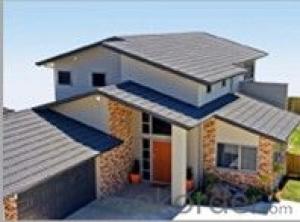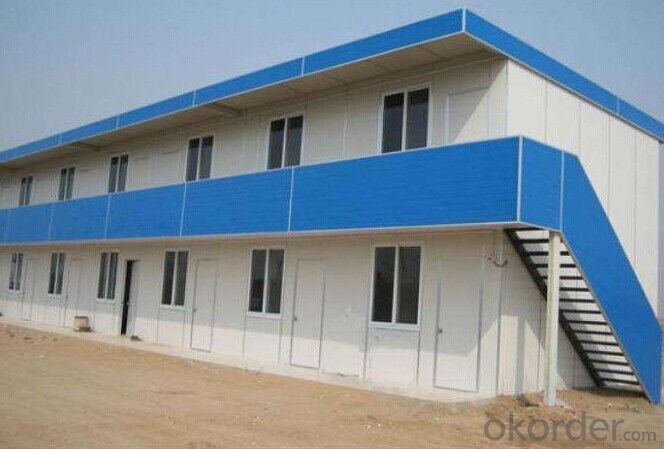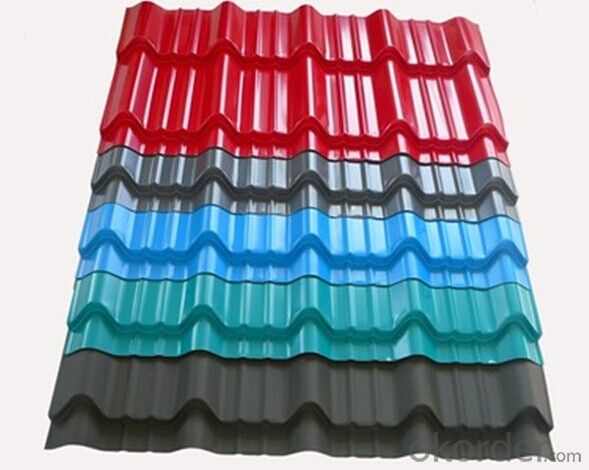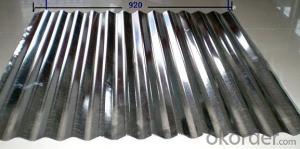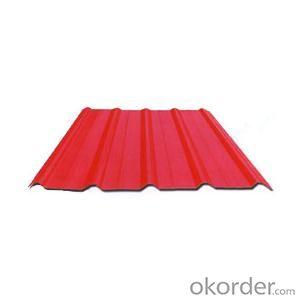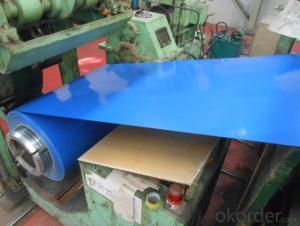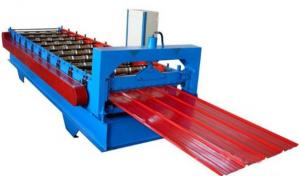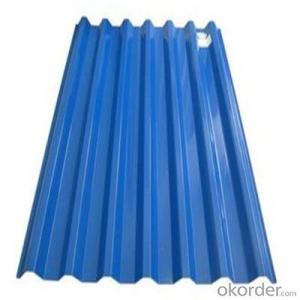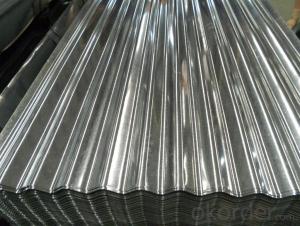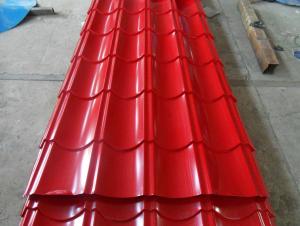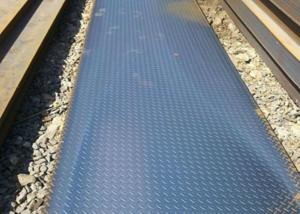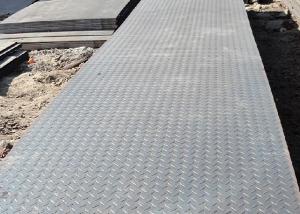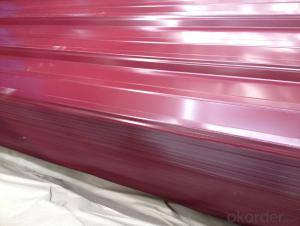Prepainted galvanized corrugated steel sheet
- Loading Port:
- China Main Port
- Payment Terms:
- TT OR LC
- Min Order Qty:
- -
- Supply Capability:
- -
OKorder Service Pledge
OKorder Financial Service
You Might Also Like
Specifications
Product name | Prepainted galvanized corrugated steel sheet |
Length | As your requirement |
Width Length | 600mm-1250mm or as your requirement as your requirement |
Thickness | 0.2mm-2mm |
Color | Ral NO. |
Bundle weight | As client's requirement |
Zinc coating | 40-275g/m2 |
Quality standard | JIS G3002 , JIS G3312 |
Lacquer | According to your needs |
Term | FOB,CFR,CIF |
Coil ID | 508mm,610mm |
Top coating | 15-25microns |
Back coating | 5-10microns |
MOQ | 50 tons |
Base material | Hot dipped galvanized steel coil |
Packaging Detail | 1.Coil then to be properly wrapped with water proof /resistant paper, it then to be properly and completely metal wrapped. 2.Wooden and iron pallet can be used or as your requirements. 3.And each packed coil to be properly wrapped with band, three-six such band through the eye of coil at about equal distance, and two-four such bands securely tied around belly of coil at about equal distance |
Delivery Detail | 40 days |
advantages
1.We had already passed the authentification by the ISO9001 and established a completed set of quality assurace system.
2.Under such a complete set of quality assurance systems,there is a complete set of regulations for ordering,order handing,quality design,purchasing raw materials,working ot production plan,prodction,test and inspection,packaging,storage,delivering,etc.
3.The PC-based production and marketing system not only improves the working efficiency but also ensres the quality of product.
4.Our PPGI lines are equipped with a large amount of online test instruments so that they can ensure and improve the quality of product.
- Q: How do you prevent galvanic corrosion when using steel sheets in contact with water?
- One way to prevent galvanic corrosion when using steel sheets in contact with water is by applying a protective coating on the steel surface. This coating acts as a barrier, preventing direct contact between the steel and water, thereby reducing the chances of galvanic corrosion. Additionally, using corrosion-resistant materials like stainless steel or galvanized steel can also help prevent galvanic corrosion in such scenarios.
- Q: Are steel sheets suitable for high-vibration environments?
- Steel sheets are generally suitable for high-vibration environments due to their inherent strength and durability. Steel is known for its excellent mechanical properties, including high tensile strength and resistance to fatigue. These qualities make steel sheets capable of withstanding vibrations without significant deformation or failure. Moreover, steel sheets have the ability to dampen vibrations due to their mass and stiffness. This makes them effective in reducing the transmission of vibrations to other components or structures. Steel sheets can absorb and dissipate the energy generated by vibrations, minimizing the potential for damage or disruption. Additionally, steel sheets can be designed and manufactured to meet specific requirements for high-vibration environments. They can be reinforced or treated with coatings to enhance their resistance to corrosion, wear, and fatigue, further improving their suitability for such conditions. However, it is essential to consider the specific characteristics and intensity of the vibration environment when determining the suitability of steel sheets. Factors such as frequency, amplitude, and duration of vibrations should be taken into account. In some extreme cases, alternative materials or specialized designs may be necessary to ensure optimal performance and longevity. In conclusion, steel sheets are generally suitable for high-vibration environments due to their strength, durability, and ability to dampen vibrations. However, a thorough evaluation of the specific conditions is crucial to determine the most appropriate solution for each application.
- Q: What are the different methods of cleaning steel sheets?
- There are several methods of cleaning steel sheets, including mechanical methods such as scrubbing or sanding, chemical methods like using solvents or detergents, and thermal methods like heat treating or flame cleaning.
- Q: Are steel sheets resistant to warping or bending under load?
- Yes, steel sheets are generally resistant to warping or bending under load due to their high strength and stiffness.
- Q: What are the color options for steel sheets?
- The color options for steel sheets vary depending on the specific type of coating or finish applied. Common color options include white, black, gray, blue, green, red, and metallic shades such as silver and gold. Additionally, custom colors can be achieved through processes like powder coating or painting.
- Q: How are steel sheets cleaned and maintained?
- There are various methods available for cleaning and maintaining steel sheets, depending on specific requirements and conditions. Below are some commonly used approaches: 1. Regular cleaning: It is important to clean steel sheets regularly to eliminate dust, dirt, and other debris that may accumulate on the surface. This can be accomplished by using a soft cloth or sponge along with mild soap or detergent and warm water. It is advisable to avoid abrasive cleaners or scrub brushes that can cause surface scratches. 2. Rust removal: Prompt removal of rust spots is crucial to prevent further corrosion on steel sheets. Rust can be eliminated using a wire brush, sandpaper, or a rust remover solution. Once removed, the area should be thoroughly cleaned and dried. 3. Protective coating: Applying a protective coating can help prevent rust and corrosion, especially for steel sheets exposed to harsh environments or moisture. Coating options include paint, varnish, or specialized anti-corrosion coatings. The coating should be applied in accordance with the manufacturer's instructions and reapplied periodically as needed. 4. Proper storage: To prevent moisture buildup and corrosion, it is important to store steel sheets in a dry and well-ventilated area. They should be kept away from direct contact with the ground and other metals to avoid galvanic corrosion. Additionally, using covers or protective wraps can provide further protection against dust and other contaminants. 5. Periodic inspection: Regularly inspecting steel sheets for any signs of damage, such as dents, scratches, or cracks, is essential. If any damage is identified, it should be promptly repaired to prevent further deterioration. 6. Professional maintenance: In the case of large-scale or complex steel sheet installations, it may be necessary to enlist professional maintenance services. These experts possess the knowledge, tools, and experience required to perform more extensive cleaning, maintenance, and repairs. By adhering to these cleaning and maintenance practices, steel sheets can maintain their integrity, appearance, and performance over time.
- Q: What is the process of etching designs on steel sheets?
- The process of etching designs on steel sheets typically involves several steps. First, a design or pattern is created on a stencil or mask, which is then applied to the steel sheet. The sheet is then coated with an acid-resistant material, such as wax or photoresist, leaving only the desired design exposed. Next, the sheet is submerged in an acid bath, which chemically erodes the exposed areas, creating the etched design. The sheet is then removed from the acid bath, cleaned, and the remaining acid-resistant material is removed, revealing the finished etched design on the steel sheet.
- Q: Can steel sheets be used in food processing or medical industries?
- Yes, steel sheets can be used in food processing or medical industries. Stainless steel sheets, in particular, are commonly utilized in these industries due to their excellent corrosion resistance, hygienic properties, and ease of cleaning. They are often used to manufacture equipment, surfaces, and utensils that come in direct contact with food or are used for medical procedures, ensuring safety and preventing contamination.
- Q: Can the steel sheets be easily cleaned?
- Yes, steel sheets can be easily cleaned. Steel is known for its durability and ease of maintenance. It can be wiped clean using a damp cloth or sponge with mild soap or detergent. For tougher stains or grime, a non-abrasive cleaner can be used. Additionally, steel sheets are resistant to rust and corrosion, making them suitable for various environments and easy to maintain in the long run.
- Q: What is the difference between an open plate and an original plate?
- Open plate and the original plate are many industries are commonly used plate, although the appearance of such two plates are very similar, but there are other essential differences, these we all want to clear.x0d
Send your message to us
Prepainted galvanized corrugated steel sheet
- Loading Port:
- China Main Port
- Payment Terms:
- TT OR LC
- Min Order Qty:
- -
- Supply Capability:
- -
OKorder Service Pledge
OKorder Financial Service
Similar products
Hot products
Hot Searches
Related keywords
